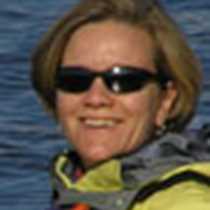Glacier Bay National Park
After two full days exploring the wildness that is Southeast Alaska, our senses are tuned. We’ve settled into the rhythms of shipboard life, and tumble out on deck at the first sound of a slowing engine. Our reward is to watch a brown bear foraging on beach grasses, and we’re completely engrossed in the moment. We hear a distinctive bird call and immediately begin searching for the source of the sound. In so doing, we’re treated to the sight of a black oystercatcher’s long, red bill, or a flock of black-legged kittiwakes taking flight off the water.
Today, then, was perfect for engaging these newly remembered senses. Glacier Bay National Park has been a natural laboratory for the study of glacial landscapes and primary plant succession for more than a century, but it was brand new to us today. As we traveled 65 miles into the raw, icy, uppermost reaches of the bay, we saw, heard, smelled and felt more than we had perhaps thought possible.
Early risers smelled the clean, sharp scent of young spruce forest mixed with the sulfurous odor of low tide, as we left the dock at Bartlett Cove. After breakfast, at South Marble Island, we listened to the deep growls of Steller sea lions, the high whistles of pigeon guillemots and the cacophonous cries of kittiwakes and gulls. We watched tufted puffins on the water and in flight, hilarious despite their best efforts.
Our day progressed beautifully. A brief stop in North Sandy Cove yielded no wildlife, but we caught fragrant whiffs of young cottonwood across the deck. Stopping for mountain goat nannies and kids at Gloomy Knob, someone commented on the apparent silkiness of their wool. Our shipboard geologists, Doris Sloan from Cal Alumni and NPS Ranger Richard Becker, drew our attention to the grooved and sculpted surface of this dolomitic headland. Waiting patiently in front of the mass of Margerie Glacier, there was conversation about the impossible blue of the ice, and the fantastically sculpted spires at the glacier’s face.
Our afternoon was warmed by brilliant sunshine and highlighted by a mother brown bear with her two cubs. All three galloped down a steep, snow-covered slope, capturing our attention from afar. Quiet cruising back down the bay led to contemplation and conversation, and tacit acknowledgment of the power of wild places.
After two full days exploring the wildness that is Southeast Alaska, our senses are tuned. We’ve settled into the rhythms of shipboard life, and tumble out on deck at the first sound of a slowing engine. Our reward is to watch a brown bear foraging on beach grasses, and we’re completely engrossed in the moment. We hear a distinctive bird call and immediately begin searching for the source of the sound. In so doing, we’re treated to the sight of a black oystercatcher’s long, red bill, or a flock of black-legged kittiwakes taking flight off the water.
Today, then, was perfect for engaging these newly remembered senses. Glacier Bay National Park has been a natural laboratory for the study of glacial landscapes and primary plant succession for more than a century, but it was brand new to us today. As we traveled 65 miles into the raw, icy, uppermost reaches of the bay, we saw, heard, smelled and felt more than we had perhaps thought possible.
Early risers smelled the clean, sharp scent of young spruce forest mixed with the sulfurous odor of low tide, as we left the dock at Bartlett Cove. After breakfast, at South Marble Island, we listened to the deep growls of Steller sea lions, the high whistles of pigeon guillemots and the cacophonous cries of kittiwakes and gulls. We watched tufted puffins on the water and in flight, hilarious despite their best efforts.
Our day progressed beautifully. A brief stop in North Sandy Cove yielded no wildlife, but we caught fragrant whiffs of young cottonwood across the deck. Stopping for mountain goat nannies and kids at Gloomy Knob, someone commented on the apparent silkiness of their wool. Our shipboard geologists, Doris Sloan from Cal Alumni and NPS Ranger Richard Becker, drew our attention to the grooved and sculpted surface of this dolomitic headland. Waiting patiently in front of the mass of Margerie Glacier, there was conversation about the impossible blue of the ice, and the fantastically sculpted spires at the glacier’s face.
Our afternoon was warmed by brilliant sunshine and highlighted by a mother brown bear with her two cubs. All three galloped down a steep, snow-covered slope, capturing our attention from afar. Quiet cruising back down the bay led to contemplation and conversation, and tacit acknowledgment of the power of wild places.



